
The Dutch landscape architecture and urban design firm WEST 8 is one of the foremost practitioners in the emergent discipline of landscape urbanism. WEST 8 creates its innovative vision through a praxis that unites a distinctive collection of architects, landscape architects, urban planners, and industrial designers. The combination of a fluid design team, a profound reading of context, and an intuitive knowledge of situation give WEST 8 an incredible basis in which to explore and fabricate the contemporary landscape.
A year or so ago at the Dutch Sustainable Waterfronts Conference in Chicago, Chief Editor John Jourden spoke with Jerry van Eyck of West 8 about the reassurance of landscape as planning, the work of WEST 8, and the situation in New Orleans.
0:10 jourden:// I’ve read somewhere that West 8 takes its name from eight winds which blow off the North Sea…
0:18 van eyck:// No. It’s only one wind. The force of the wind has a unit. Twelve is our (Dutch) hurricane which is a lot less than the Caribbean ones. An eight wind is a strong wind but it’s not a storm. (Sailors) won’t go out in an eight wind. See here on our business card, it’s a windsock, when the windsock is full, totally filled its west 8, a prevailing wind.
back of WEST 8 business card
1:12 jourden:// Can you elaborate a little on this name and how it relates to the work you do?
1:30 van eyck:// It’s a very simple story. We are very excited by the presence of the water and wind in Holland. We are based in the port of Rotterdam—our office is in the port. From the view at my desk I can always see ocean liners and things…
It’s basically a fascination with water and wind and not a denial of these aspects of the country. Wind and water that’s it and we’re proud of it.
2:55 jourden:// You were trained as a landscape architect and industrial designer. How do these two seemingly disparate disciplines coalesce in your work at West 8?
3:15 van eyck:// This is my personal twist of course. My colleagues don’t have this dual approach in their education. Some of them do have two, but then its architect and urban designer or something much more in the same line. I don’t know, I guess I migrated a few scales upward. I’ve always been involved in West 8, but in the beginning it was sort of on a freelance basis, but the relationship became stronger and stronger and stronger.
My early way of approaching a design was always larger scale projects; thirty-meter height hydraulic lampposts and things like that. [laughs]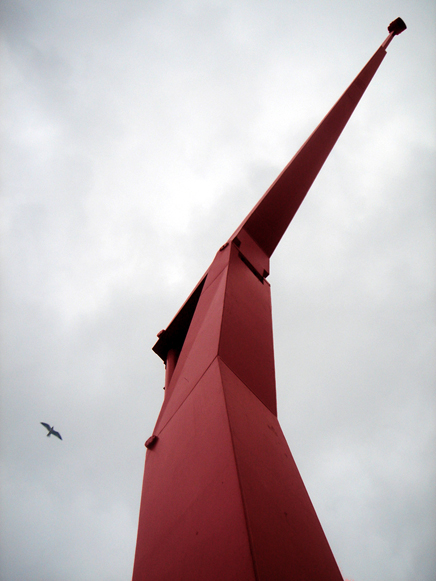
One of the four lamp standards on the Schouwburgplein in Rotterdam. Photograph by Mariëlle Ernst
4:17 jourden:// You did those in the square in Rotterdam? That was your design?
4:21 van eyck:// Yeah, but it’s a quite old design.
4:26 jourden:// They’re beautiful though. I like them a lot…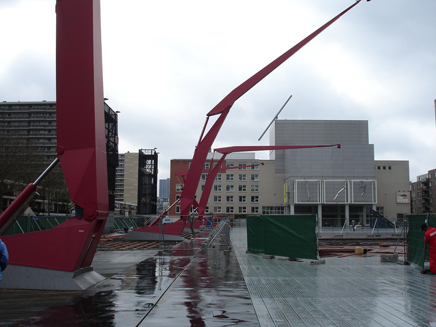 Schouwburgplein in Rotterdam Photograph by Steven Ward
Schouwburgplein in Rotterdam Photograph by Steven Ward
4:32 jourden:// Your partner at West 8, Adriaan (Geuze ) has stated that the “natural is not always better than the man-made.” Can you explain or justify this concept as though I were a hardcore environmentalist?
[laughs]
4:55 van eyck:// It’s a genetic thing—the history and tradition of Dutch engineering, of thinking in terms of manipulating nature. Our whole country is man-made. It’s normal. We love nature, but it’s also a way of survival, sometimes you have to manipulate it (nature). If you project that from let’s say an urban city—a planning takes place. It needs green lungs for people’s well-being, so you create parks and things preferably using existing and domestic nature.
I made this note from the talk from Shane (Coen ), and he said in an American situation (which is more or less where the discussion is tending towards—an American situation versus European situation) there is an understanding for an aesthetical approach—with an aesthetical integration into designs such as in Holland. (Coen) said this and I was quite astonished because an aesthetical approach is not at all what we are doing. It’s not at all.
7:28 jourden:// It is in a way though because it’s a collective agreement.
7:32 van eyck:// It’s not at all aesthetical as a starting point. It really comes from the starting point of logic and context. The key answer then is context and an intensive analysis of it, produces automatically the design.
8:22 jourden:// I think you can see that in your work, in this idea of mapping and trying to figure it out. Maybe that does come from this element of survival. And that is very much from my own perception of the Dutch.
8:40 van eyck:// Aesthetical, that’s you know interior decorators, these are aesthetical people—and fabric designers that’s aesthetical. What we are doing is not aesthetical. Aesthetical means visual pleasing or something yeah?
8: 59 jourden:// But you are making the choices…
9:06 van eyck:// We try to stay away seriously from the whole debate about taste. Yeah?
9:16 jourden:// Yeah? But once you’re making choices. (We’re getting off the subject here, but I think it’s interesting.) But once you’re starting to make choices about what is contextual and what is important in a certain situation those are aesthetical choices—you’re making choices that have to do with aesthetics. Don’t you think?
9:40 van eyck:// We don’t feel it like that—its partially analysis of the context and partly intuition, especially intuition. Intuition is a multiply interpretative operation.
10:03 jourden:// There hasn’t been much talk about landscape architecture until recently. But now there seems to be very much a renaissance of the discipline, and a lot of people are talking about it as renaissance. But as a component of popular culture, it’s being reintegrated into the consciousness…
10:30 van eyck:// Bare in mind that Holland is maybe one of the only countries, maybe there are a few others, where you can actually get a training as an urban designer. In most countries architects do the urban planning and urban designing. Where we come from the architects follows the master planner. Of course landscaping is more part of the master planning process. So we come first! And then the architect. It’s not at all about filling up or decorating up the negative architectural spaces.
11:22 jourden:// Can you offer me an explanation why there is this resurgence here, as perhaps its been that way for awhile in The Netherlands…
11:38 van eyck:// Yes, well I think it’s collective awareness, it’s evolution, it’s natural, it’s education—this is a good development, it’s going in the right direction.
12:02 jourden:// Especially with the icecaps melting. I hope we can reverse this before you’re underwater over there. [laughs]
[laughs]
12:09 van eyck:// I mean look though you guys are going underwater now as well.
12:12 jourden:// It seems. But we’re all intertwined now and we’re starting to see that, or at least some people are…
Your website offers a unique position on the role of landscape, architecture, and urban planning. It’s a position that talks about creating narrative spaces. Can you discuss the idea of creating narrative spaces within a contemporary landscape? And how those work—what they are and how they’re part of the design process?
13:02 van eyck:// In a way that also has to do with the context of course. But narrative spaces—I guess the best way to explain it is as human interaction with the environment.
I just had a very interesting discussion with Jurgen (Bey ), a product designer about ergonomics …we both don’t believe in it!
[laughs]
You really have to experience your surroundings, your environment—it’s nice to feel that your holding this cup or this door handle, it’s nice to feel alive when you walk through the rain. It’s also your own personal experience. You will interact with a city much differently than I do. Where there is always a kind of sequential scenario that is part of your life. Isn’t it? And our work is to provide for that environment…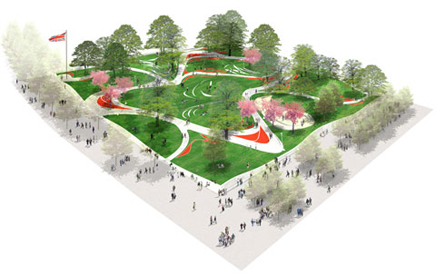
The Jubilee Gardens (2005) WEST 8
14:55 jourden:// It’s a narrative which is chosen by the user, it’s not a narrative that you guys are necessarily designing…
15:02 van eyck:// No, no we are not making a handbook. It’s really for the people and everybody has to experience their own narrative story. Or hate it, yeah? Also possible, and it’s fine with me.
17:50 jourden:// The Jubilee Gardens has had a lot of talk swirling around it—was there a lot of opposition or controversy, because if you look what’s there now there is nothing—virtually, its empty.
18:25 van eyck:// No, it is nothing, completely nothing but it’s of course one of the world’s most prime locations—very prestigious. We making a new green Trafalgar Square over there and they’re nervous about it. That’s it nervousity [sic], and there have been so many plans for it. We were never worried. We won the design competition for it and we’re building it!
The Jubilee Gardens (2005) WEST 8
19:15 jourden:// In the projects I saw in your lecture there seems to be a difference between the projects aboard and the ones at home in The Netherlands. Is there more freedom in interpreting the landscape there, because it’s always changing?
19:31 van eyck:// No. What you see maybe in the—difference—well I never really thought about them in that way, but if you see difference in our projects aboard compared to our ones in Holland then our mission has succeeded. Because we try to relate to the context, so its basically analyzing and then the outcome is unpredictable—there is no off-the-shelf West 8 design.
20:09 jourden:// Right, but there seems to be this—like in the dunescape project you showed, since The Netherlands has always been a landscape influx does it open itself up for more interpretation?
20:45 van eyck:// No. Not really.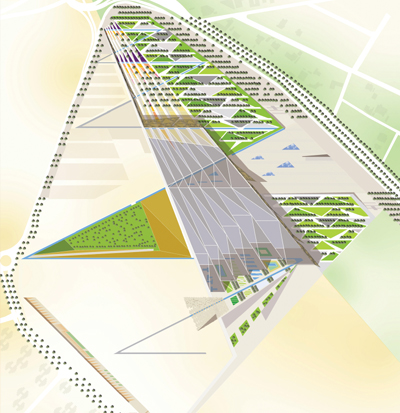
GME Museum, Giza (2004) WEST 8
21:02 jourden:// Despite scale and local can you discuss the strategies West 8 uses in projects like the Theater Square (Schouwburgplein) in Rotterdam, the Jubilee Gardens, and the Grand Egyptian Museum landscaping in terms of those three projects…
21:29 van eyck:// You don’t see a similarity in its appearance—in those projects.
21:33 jourden:// No!
21:35 van eyck:// Good, just checking.
21:40 jourden:// No, I don’t think so, but there is a similarity in terms of the approach (to me anyway) in digesting what the situation is. And then taking that situation and sort of reinterpreting it either from a larger context on to a smaller site. So there is a sort of…
22:05 van eyck:// Also visa-versa. If you make the synthesis, which is your design, it will definitely affect the context again, so the context will response to it. For instance, the Egyptian project which is basically creating new parks automatically all kinds of functions, urban functions will emerge around it; commercial, residential, et cetera, et cetera.
22:54 jourden:// Does the condition of Dutch pragmatism or class influence the ideas of creating Dutch landscape and urbanism? I’d like to relate this back to New Orleans where you have these definite divisions between classes…
23:24 van eyck:// Well during the planning process all kinds of ethnic backgrounds are taken into account. One thing you do when planning is you don’t make ghettos. Everything you do is to not make ghettos. We strongly believe in mix-use, mix-function, mix-cultural, mix-age.
Borneo Sporenburg (1993) WEST 8 Photographs by Ludwig Abache
25:08 jourden:// Do market forces influence and impact developments in The Netherlands in terms of these mixing urban concepts?
25:25 van eyck:// They do. I’m not the urban planner of the office, but I can tell you that in an urban design you make sure there is variety in housing woven in the fabric: high-end housing, rental places, dwellings for purchase and everything in between.
Borneo Sporenburg (1993) WEST 8 Photographs by Ludwig Abache
26:18 jourden:// Looking back at the catastrophe in The Netherlands in the 1950s and the governmental response which created the Delta Works system, and considering the somewhat analogous situation occurring in New Orleans—and knowing the situation here what do you think we should do from a Dutch perspective?
26:56 van eyck:// In The Netherlands this is also a recent awareness. A dike is basically stopping leakage with a mop. Its not completely solid or sealed you always have to work on it. Its basically you have to turn off the tap to stop the leakage. At this moment there is no clear solution to the problem. We can do all the efforts we can to make the best works of engineering and put lots of money into it, but vulnerability will always remain. And that’s a global problem.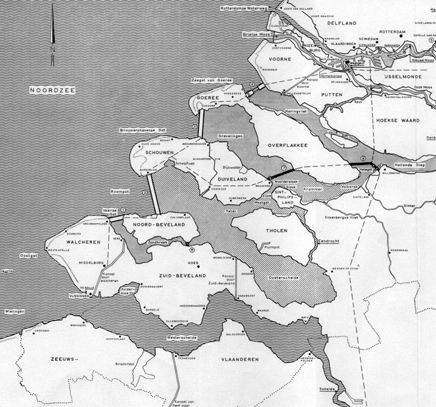
Map of the Deltawerken Project
28:07 jourden:// How do you see the political will that created the Delta Works—I guess what I’m seeing here is that we’re concentrating on who’s responsible for this fallout instead of looking at the entire picture for the future.
28:29 van eyck:// Exactly, but your culture is completely different. To put it very simply, the US has a lot of luxury and this softens the discipline to take care of all these sustainable aspects of a lasting country. The Dutch by necessity have always had this. It started way back in the Middle Ages, the Dutch are therefore hundreds of years ahead of America in this capacity. I’m not saying it’s somebody’s mistake or that we are better, on the contrary, because in the end the Chinese are always better—mark my words…
It's not that somebody is better than the other, it’s just a matter of tradition or cultural background. It’s starting to come up now especially for our incoming generations. There has never been such a big deal in planning of cities. Usually you have a parcel you buy it, you put a building on it, and make profit by selling the thing. And then buy another one. That’s it, that’s the planning, which also makes it very attractive.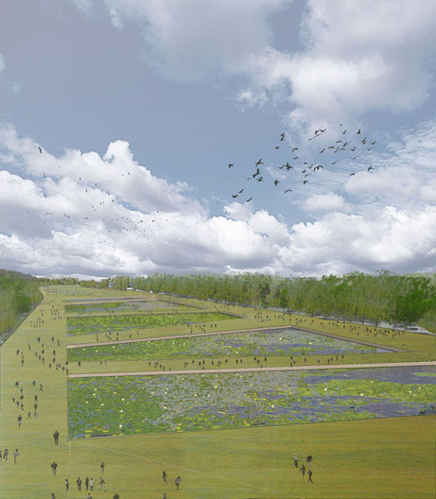 Miniature Delta for New Orleans (2006) WEST 8
Miniature Delta for New Orleans (2006) WEST 8
31:03 jourden:// The current idea to replan New Orleans under free market forces allows for a solution to create the prefect or ideal American city…
31:27 van eyck:// The opportunity is there. Every disaster means an opportunity. That is the other thing of course. We had the Second World War, which completely devastated the whole country. Completely disastrous with millions killed, but on the other hand it meant the opportunity to create a better country. Very strange to say that but it’s the truth.
Look at all the losses in New Orleans and the people’s minds at work. People are extra motivated to make the city better. Am I right? There is almost no grief. There is almost no grief…
33:46 jourden:// I think there is a lot of suspicion, this is what it comes down to. Suspicions in that, poorer areas are going to be displaced and they don’t have necessarily have the recourse in changing this. And the issue is that in most cases they are the people whom made the city great, because they are the ones that created its lore…
34:15 van eyck:// Your right. I have never had to think about that, because I don’t think in that way. But I think your right this is something you really have to be careful for.
34:29 jourden:// Well maybe in twenty years or so there will be a city in The Netherlands that becomes predominantly Muslim and has a cultural renaissance. Then its whipped out in a disaster twenty years after, would you guys rebuild it? This is just a hypothetical here…
35:05 van eyck:// Well that is something to be reckoned with. [laughs]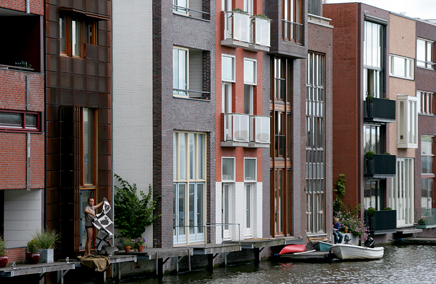
Borneo Sporenburg (1993) WEST 8 Photographs by Ludwig Abache
Creative Commons License
This work is licensed under a Creative Commons License .
/Creative Commons License
5 Comments
Thanks for staying on message about the aestheticism - I thought even designers themselves don't buy their own "the design is produced automatically by data"-bullshit. Well, I was wrong about that, it seems. Delusional & trying to seem super-rational seems to be the recipe still.
Also, the last bit of conversation on New Orleans just shows how "automatic" these designs really end up being... Exploitative and heavy handed proposals, driven by tightly chosen likes and dislikes masked and strenghtened as objectivity. Also, the lot of the poor gets attention first when their role in a city is framed as a cultural asset (read: tourism revenues).
A good and revealing interview.
this symposium at iit was a while ago...why the late release?
yeah, well as much as I like to do these things for you all, it doesn't pay the bills and sometimes something has to give. and well this was one of those things...so think of it more as the one that got away and came back to you. (plus this interview has nothing to do with the event)
thanks for realing it back in, John.
I saw the New Orleans exhibit at the National Building Museum in DC this past June. The proposals by West 8 and MorphOsis stood out from the others by being at once sensative to reality and visionary...
It's basically a fascination with water and wind....
"Water and wind", "Feng-shui" in Chinese- another landscape siting and design theory. Coincidence?
Block this user
Are you sure you want to block this user and hide all related comments throughout the site?
Archinect
This is your first comment on Archinect. Your comment will be visible once approved.